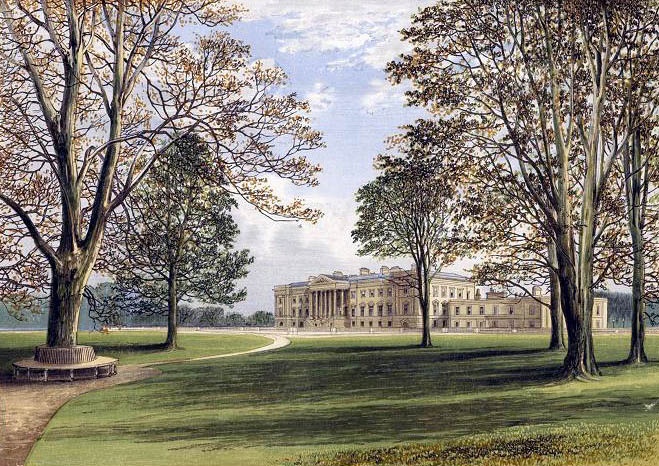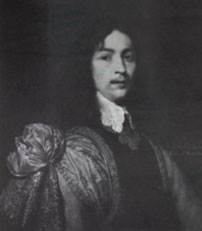|
Sandon Hall
Sandon Hall is a 19th-century country mansion, the seat of the Earl of Harrowby, at Sandon, Staffordshire, northeast of Stafford. It is a Grade II* listed building set in of parkland. Early manorial history Before the Norman Conquest, Sandon was the property of Ælfgar, Earl of Mercia, but at the Conquest it fell into the king's hands, who bestowed it upon Hugh Lupus, Earl of Chester. From him it passed to William de Malbanc, of Nantwich, one of his barons. Adena, the great-grand-daughter of William, gave it to Warren de Vernon, whose daughter Alditha conveyed it to Sir William Stafford, knight. Erdeswicke Margaret, daughter of one of the descendants of Sir William Stafford, carried the manor of Sandon by marriage to Thomas Erdeswicke in the 12th year of the reign of Edward III (1339). Thomas and Margaret had a son Thomas, whose four sons were Hugh, Robert, Sampson, and Henry. Hugh, Robert and Sampson all died without issue, but Henry had a son Hugh, who had issue ano ... [...More Info...] [...Related Items...] OR: [Wikipedia] [Google] [Baidu] |
Richard Erdeswicke
Richard Erdeswicke (1594-1640) was an English MP, whose public career was hampered by debt. Life Erdeswicke was the son of the Staffordshire antiquary Sampson Erdeswicke by his second wife Mary (née Neale), daughter of Francis Neale of Keythorpe in Leicestershire. His family were staunchly recusant. He was still a minor when his father died and his wardship was acquired by Thomas Gerard, 1st Baron Gerard, who sold it back to Erdeswicke's mother. His mother borrowed money from his half-brother Sir Everard Digby to purchase Erdeswicke's wardship, which led to complications when Everard was executed for his part in the 1605 Gunpowder Plot and his estate confiscated by the Crown. Despite his family's Catholicism, Erdeswicke was educated at Eton, Cambridge and the Inns of Court. He married Anne Orwell, while still a minor. His half-brother George Digby was a friend of George Villiers, 1st Duke of Buckingham and the influence of the king's favourite enabled Erdeswicke to pursue a pub ... [...More Info...] [...Related Items...] OR: [Wikipedia] [Google] [Baidu] |
Nathaniel Ryder, 1st Baron Harrowby
Nathaniel Ryder, 1st Baron Harrowby (3 July 1735 – 20 June 1803) was a British politician who sat in the House of Commons from 1756 to 1776 when he was raised to the peerage as Baron Harrowby. Ryder was the son of Sir Dudley Ryder, Lord Chief Justice of the King's Bench. He was admitted at Clare College, Cambridge in 1753. In 1756, Ryder was elected Member of Parliament for Tiverton, a seat he held until 1776. On 20 May 1776 he was raised to the peerage as Baron Harrowby, of Harrowby in the County of Lincoln. He later served Deputy Lieutenant of Staffordshire and Lincolnshire. Lord Harrowby married Elizabeth Terrick, daughter of the Right Reverend Richard Terrick, Bishop of London, in 1762. Their second son the Hon. Richard Ryder became a successful politician and served as Home Secretary from 1809 to 1812 while their youngest son the Hon. Henry Ryder became Bishop of Gloucester and Bishop of Lichfield. Lord Harrowby died in June 1803, aged 67, and was succeeded in the b ... [...More Info...] [...Related Items...] OR: [Wikipedia] [Google] [Baidu] |
Joseph Pickford
Joseph Pickford (bap. 6 October 1734 – 13 July 1782) was an English architect that mostly worked within the English county of Derbyshire, and was one of the leading provincial architects in the reign of George III. The house he designed for himself in Derby is now the Pickford's House Museum. Biography Pickford was born in Warwickshire in 1734 but he moved as child to London when his father, William Pickford, died in 1742. Pickford's initial training was undertaken under the stonemason and sculptor Joseph Pickford (his uncle), at his Hyde Park, London premises. Pickford worked with his uncle for about ten years, training first as a mason and then as an architect. Pickford at one time had offices in both London and Derby. The architect moved to Derby in circa 1760, where he was the agent of Foremarke Hall architect David Hiorne of Warwick. He was married to Mary, daughter of Thomas Wilkins who was the principal agent of Wenman Coke of Longford Hall, Derbyshire which Pickfor ... [...More Info...] [...Related Items...] OR: [Wikipedia] [Google] [Baidu] |
Archibald Hamilton, 9th Duke Of Hamilton
Archibald Hamilton, 9th Duke of Hamilton and 6th Duke of Brandon (15 July 1740 – 16 February 1819) was a Scottish peer and politician. Background and education Hamilton was the second son of the 5th Duke of Hamilton, by his third wife, Anne Spencer, and was educated at Eton. He was uncle to Douglas Hamilton, 8th Duke of Hamilton who died without legitimate issue. Political career In 1768, Hamilton became member of parliament for Lancashire and held the seat until 1772 when he was appointed a Steward of the Chiltern Hundreds. In 1799, he inherited his half-nephew's titles and was appointed his successor as Lord Lieutenant of Lanarkshire. Horse racing Hamilton was a prominent figure in the world of Thoroughbred horse racing. Between 1786 and 1814 his horses won seven runnings of the St Leger Stakes at Doncaster. Family On 25 May 1765, he married Lady Harriet Stewart (a daughter of the 6th Earl of Galloway) and they had five children: * Lady Anne (1766–1846), lady- ... [...More Info...] [...Related Items...] OR: [Wikipedia] [Google] [Baidu] |
Charles Mohun, 4th Baron Mohun Of Okehampton
Charles Mohun, 4th Baron Mohun ( – 15 November 1712), was an English politician best known for his frequent participation in duels. He was killed in the Hamilton–Mohun duel in Hyde Park, London. Biography Mohun was the second child of Charles Mohun, 3rd Baron Mohun, and his wife Philippa Annesley, a daughter of Arthur Annesley, 1st Earl of Anglesey. His father died shortly after his birth, following a duel, and left him the family estate. The estate, however, was heavily in debt. Due to this Mohun received no education, and was forced to resort to gambling in order to support his lavish lifestyle. Mohun married Charlotte Orby, granddaughter of Charles Gerard, 1st Earl of Macclesfield, in 1691 with the hope that this match would alleviate some of his debt. Unfortunately, he received no dowry for the marriage, and the couple separated shortly thereafter. Following the separation, Mohun's behaviour became ever more licentious. A gambling dispute in late 1692 resulted ... [...More Info...] [...Related Items...] OR: [Wikipedia] [Google] [Baidu] |
James Hamilton, 4th Duke Of Hamilton
Lieutenant-General James Hamilton, 4th Duke of Hamilton and 1st Duke of Brandon (11 April 1658 – 15 November 1712), was a Scottish nobleman, soldier and politician. Hamilton was a major investor in the failed Darien scheme, which cost many of Scotland's ruling class their fortunes. He led the Country Party in the Parliament of Scotland and the opposition to the Act of Union in 1707. He died on 15 November 1712 as the result of a celebrated duel in Hyde Park, Westminster, with Charles Mohun, 4th Baron Mohun, over a disputed inheritance. Early life The eldest son of William Douglas, 1st Earl of Selkirk (who was created Duke of Hamilton for his lifetime and changed his surname to Hamilton in 1660), and his wife Anne, 3rd Duchess of Hamilton in her own right, Hamilton was born at Hamilton Palace, in Lanarkshire. He was a descendant through his mother of the Scottish House of Stewart and therefore had a significant claim to the thrones of both Scotland and England. He was ... [...More Info...] [...Related Items...] OR: [Wikipedia] [Google] [Baidu] |
Charles Gerard, 1st Earl Of Macclesfield
Charles Gerard, 1st Earl of Macclesfield, PC (c. 16187 January 1694) was an English aristocrat, soldier and courtier. He fought as a Royalist during the English Civil War, before spending a period in exile under the Commonwealth. After returning to England upon the Stuart Restoration in 1660, he was made Earl of Macclesfield by Charles II in 1679. He later fell out of royal favour and was declared an outlaw, but after a second period on the continent, he returned to England in 1688 in the retinue of William of Orange. He received several offices under the crown, including serving as the last Lord President of Wales in 1689. Early life The eldest son of Sir Charles Gerard, he was a member of an old Lancashire family, his great-grandfather having been Sir Gilbert Gerard (died 1593) of Ince, in that county, one of the most distinguished judges in the reign of Elizabeth I. His mother was Penelope Fitton, sister and co-heiress of Sir Edward Fitton, of Gawsworth, Cheshire. Nothi ... [...More Info...] [...Related Items...] OR: [Wikipedia] [Google] [Baidu] |
Baron Gerard
There have been three baronies created for the Gerard family who lived historically at Bryn, Greater Manchester, Bryn, Ashton-in-Makerfield, Lancashire and Kingsley, Cheshire, in the 13th century. The third and current barony was created in 1876. History The earliest traceable member of the family that gave rise to the Barons Gerard was a William Fitz Gerard, who lived during the reign of Henry III of England and obtained his lands in Kingsley, Cheshire, by marriage Emma, daughter of Richard de Kingsley. Traditional genealogical sources have shifted this man back in time and given the family a shared origin with the Hiberno-Norman FitzGeralds, Dukes of Leinster in the Peerage of Ireland, and they adopted the same arms as that famous family, ''argent, a saltire gules'', before the 17th century in place of an earlier coat bearing a lion. They were noted as having exasperated heralds by long ignoring their entreaties to be allowed to record the family's pedigree, arms, and early l ... [...More Info...] [...Related Items...] OR: [Wikipedia] [Google] [Baidu] |
Caspar Schoppe
Caspar Schoppe (27 May 1576 – 19 November 1649) was a German catholic controversialist, philosopher and scholar. Life He was born at Neumarkt in the upper Palatinate and studied at several German universities. He converted to Roman Catholicism in about 1599, after reading the ''Annales Ecclesiastici'' of Baronius. Schoppe obtained the favour of Pope Clement VIII, and distinguished himself by the virulence of his writings against the Protestants. He became involved in a controversy with Joseph Justus Scaliger, formerly his intimate friend, and others; wrote ''Ecclesiasticus auctoritati Jacobi regis oppositus'' (1611), an attack upon James I of England; and in '' Classicum belli sacri'' (1619) urged the Catholic princes to wage war upon the Protestants. In about 1607, Schoppe entered the service of Ferdinand, archduke of Styria, afterwards Ferdinand II, Holy Roman Emperor, who found him very useful in rebutting the arguments of the Protestants, and who sent him on several diplom ... [...More Info...] [...Related Items...] OR: [Wikipedia] [Google] [Baidu] |



